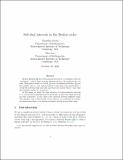Self-dual intervals in the Bruhat order
Author(s)
Gaetz, Christian; Gao, Yibo
Download29_2020_608_ReferencePDF.pdf (267.9Kb)
Publisher Policy
Publisher Policy
Article is made available in accordance with the publisher's policy and may be subject to US copyright law. Please refer to the publisher's site for terms of use.
Terms of use
Metadata
Show full item recordAbstract
Abstract: Björner and Ekedahl (Ann Math (2) 170(2):799–817, 2009) prove that general intervals [e,w] in Bruhat order are “top-heavy”, with at least as many elements in the i-th corank as the i-th rank. Well-known results of Carrell (in: Algebraic groups and their generalizations: classical methods (University Park, PA, 1991), volume 56 of proceed-ings of symposium on pure mathematics, pp 53–61. American Mathematical Society, Providence, RI, 1994) and of Lakshmibai and Sandhya (Proc Indian Acad Sci MathSci 100(1):45–52, 1990) give the equality case: [e,w] is rank-symmetric if and only if the permutation w avoids the patterns 3412 and 4231 and these are exactly those w such that the Schubert variety X[subscript w] smooth. In this paper we study the finer structure of rank-symmetric intervals [e,w], beyond their rank functions. In particular, we show that these intervals are still “top-heavy” if one counts cover relations between different ranks. The equality case in this setting occurs when [e,w] is self-dual as a poset; we characterize these w by pattern avoidance and in several other ways.
Date issued
2020-11Department
Massachusetts Institute of Technology. Department of MathematicsJournal
Selecta Mathematica
Publisher
Springer International Publishing
Citation
Gaetz, Christian and Yibo Gao, "Self-dual intervals in the Bruhat order." Selecta Mathematica 26, 5 (November 2020): 77 ©2020 Authors
Version: Author's final manuscript
ISSN
1420-9020